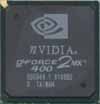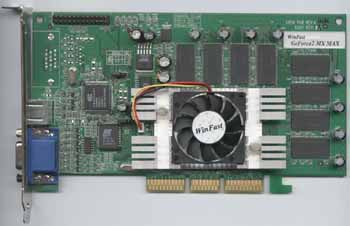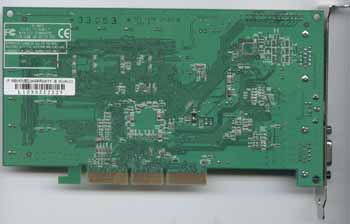
Original Link: https://www.anandtech.com/show/751
In the 10 months since the release of the first true high performance "value" video card, this segment of the market has been met with unimagined success. The June release of NVIDIA's GeForce2 MX marked the first time that a video card producer choose to release a new product for those with a budget as opposed to pushing last generation's products on these people. The GeForce2 MX quickly become one of NVIDIA's most popular products, offering 3D gaming performance while also adding in workstation graphics traits such as dual display support.
It was not long before we saw other video card producers try and beat NVIDIA at their own game. Soon after the GeForce2 MX's release, ATI announced the Radeon SDR, a card which featured good 3D support for those on a budget, but lacked the dual display functionality of the GeForce2 MX. ATI recently addressed this market with their Radeon VE card which offers limited 3D performance but supports dual display configurations. Also setting its sights upon the GeForce2 MX's workstation qualities was Matrox's G450, which, like the Radeon VE, is targeted not at the 3D gamer but the workstation owner. With these solutions costing less and outperforming NVIDIA's TwinView dual display support (see our Dual Display Comparison), it was clear that NVIDIA had to do something with the GeForce2 MX line in order to keep it competitive.
NVIDIA's solution was to segment the GeForce2 MX line into two distinct parts: the GeForce2 MX 200 and the GeForce2 MX 400. Although the GeForce2 MX 200 is NVIDIA's answer to ATI's Radeon VE and Matrox's G450, NVIDIA took this opportunity to revamp the "high-end" MX chip as well. Calling it the GeForce2 MX 400, it will be replacing the current GeForce2 MX that we have grown so accustomed to. Today we look at the new MX, the GeForce2 MX 400.
The Chip
It is no surprise that the GeForce2 MX 400 is based off the original GeForce2 MX. Before we get to what has changed, let's recap what we saw in the GeForce2 MX.
The GeForce2 MX core is based off of a crippled version of the GeForce2 GTS core. In order to separate the high-end part from the lower-end one, NVIDIA choose to limit the power of the GeForce2 MX in three ways.
First, NVIDIA cut the number of rendering pipelines in half from what is present on the GeForce2 GTS. The GeForce2 MX features only two of the GTS's four rendering pipelines, each capable of processing two texels per clock. This leaves the GeForce2 MX with half the fill rate of the GeForce2 GTS, given the same core clock speed.
The second thorn NVIDIA lodged in the GeForce2 MX's side was the use of a 128-bit SDR or 64-bit DDR memory bus. Unlike the GeForce2 GTS, which uses a 128-bit DDR memory, the GeForce2 MX is left with half the memory bandwidth of the GeForce2 GTS. As we proved in our Overclocking the GeForce2 GTS guide, the GTS is already memory bandwidth limited with its 128-bit DDR memory bus. It was therefore no surprise that the cutting of available memory bandwidth put a huge damper on the GeForce2 MX's performance. We showed in our Overclocking the GeForce2 MX guide that while increasing core speed provided almost no increase in gaming performance, increasing the memory clock speed resulted in up to a 30% performance gain.
The final handicap that the GeForce2 MX was given was a decrease in the core clock compared to the GeForce2 GTS. The GeForce2 MX comes clocked 25 MHz slower than the more powerful GTS. This leaves the core operating at 175 MHz, a speed which we knew already pushed the limits of the MX's memory bandwidth.
So, of all areas the GeForce2 MX could improve, guess which handicap gets removed in the GeForce2 MX 400 incarnation. No, NVIDIA did not choose change the core in order to increase the rendering pipeline and NVIDIA surely did not choose to pull the GeForce2 MX's largest thorn, the meager 128-bit SDR bus. Instead, the GeForce2 MX 400 improves upon the original GeForce2 MX in only one aspect: core clock speed.
That is right, the GeForce2 MX 400 is identical to the original GeForce2 MX except for the clock speed it comes shipped at. It was no secret that the original GeForce2 MX could easily reach higher clock speeds with little effort. The reference design of the GeForce2 MX does not call for any form of cooling, active or passive, and we quickly learned in the lab that slapping a heatsink and fan onto nearly any GeForce2 MX would result in the ability to overclock to at least the 200 MHz speed, if not more. In fact, even without any form of cooling, the cards would typically be able to clock near the 200 MHz mark. It is therefore no surprise that the new shipping clock speed on the GeForce2 MX 400 is not a single MHz more than 200 MHz. This places it right up to the clock speed of the GeForce2 GTS and increases the megapixel count from 350 million pixels per second to 400 million pixels per second (or 700 million texels per second to 800 million texels per second).
With two new chips, each bearing the GeForce2 MX name, and one original GeForce2 MX, things are bound to get a bit confusing. The table below should help ease that confusion.
|
Video
Card Specification Comparison
|
|||||
|
NVIDIA
GeForce2 MX 200
|
NVIDIA
GeForce2 MX
|
NVIDIA
GeForce2 MX 400
|
|||
| Core |
NV11
|
NV11
|
NV11
|
||
|
Clock Speed |
175MHz
|
175MHz
|
200MHz
|
||
| Number of Chips |
1
|
1
|
1
|
||
| Rendering Pipelines |
2
|
2
|
2
|
||
| Texels/Clock |
2
|
2
|
2
|
||
| Texels/Second |
700
Million
|
700
Million
|
800
Million
|
||
| Memory Bus |
64-bit
SDR
|
128-bit
SDR or 64-bit DDR
|
128-bit
SDR or 64-bit DDR
|
||
| Memory Clock |
166MHz
SDR
|
166MHz
SDR or 333MHz DDR
|
166MHz
SDR or 333MHz DDR
|
||
| Memory Bandwidth |
1.3
GB/s
|
2.7
GB/s
|
2.7
GB/s
|
||
| Manufacturing Process |
0.18-micron
|
||||
The Card
The first GeForce2 MX 400 card we were able to get our hands on was the Leadtek GeForce2 MX SH Max which should be one of the first GeForce2 MX 400 based cards to hit the shelves. The Leadtek GeForce2 MX SH Max comes with a few extras that we imagine will be present on many GeForce2 MX 400 based cards.
First off, the card comes with a heatsink and fan to provide a source of active cooling to the 200 MHz GeForce2 MX 400 core. Whether this is part of NVIDIA's reference design or not is unclear, but we imagine so because hitting the 200 MHz mark in this chip without any form of cooling can not be possible in every case. The GeForce2 MX cores are most likely tested after production to see if they hit the 200 MHz mark and those that do not are likely binned as GeForce2 MX 200 parts while the higher performing ones designated MX 400 parts. Even so, we suspect some form of cooling is required in NVIDIA's reference design. Although you will probably not find any naked GeForce2 MX 400 cores out there, some manufacturers may be selling cards with only a heatsink cooling solution which may not be as inclined to overclock. On the Leadtek GeForce2 MX SH Max, the heatsink and fan are bonded to the GeForce2 MX 400 core with an appropriately applied amount of thermal grease.
The second luxury item that the Leadtek GeForce2 MX SH Max is outfitted with is 64MB of RAM. Recent months have seen the trickle down of 64MB of RAM to many video cards as a result of two things. First off, RAM prices on the 6ns (166 MHz) SDR RAM pieces that this card requires are falling as faster DDR memory becomes the norm, making it cheaper for manufacturers to use 64MB on a card. The second, and more lucrative reason that manufacturers are turning to 64MB configurations is that these parts simply sell better. When on a shelf next to 32MB cards, the 64MB distinction quickly wins the hearts of the uninformed consumer. Although we know from real world experience that 64MB of SDRAM provides little to no performance over 32MB configurations (see our NVIDIA GeForce 64 MB review), uninformed buyers associate "more" with "better," making the 64MB card seem more attractive. It is true that in the long run these cards will perform better (as games get more complex), but in the current generation of games 64MB of RAM on a video card is simply unnecessary thanks to texture compression.
The Leadtek GeForce2 MX SH Max featured eight, 8MB MIRA chips rated at 6ns or 166MHz.
Also found on our Leadtek GeForce2 MX SH Max was a TV-out port powered by the popular Conexant (Brooktree) BT869KRF chip. This is another item we would not be surprised seeing on quite a few boards in order to further distinguish these cards form the regular GeForce2 MX cards.
In addition to these luxury features on the Leadtek GeForce2 MX SH Max, the board also featured some items that are not likely to be found on other GeForce2 MX 400 based boards. The two that come to mind are the hardware monitoring capabilities of the card (provided by the Winbond W83783S chip) and the addition of 3 status LEDs that aid in troubleshooting. Look for more discussion of these features and more information about this specific card in coming weeks with a Leadtek GeForce2 MX SH Max review. For now, it is time to focus on the GeForce2 MX 400 core itself.
The Drivers
The latest official driver release from NVIDIA are the Detonator3 6.50 drivers. It should come as no surprise that the GeForce2 MX 400 cards will ship with this familiar driver set.
The Test
|
Windows 98 SE Test System |
|||||||
|
Hardware |
|||||||
| CPU(s) | AMD Athlon-C (Thunderbird) 1.0GHz (133MHz) | ||||||
| Motherboard(s) | ASUS A7V133 | ||||||
| Memory | 128MB PC133 Corsair SDRAM (Micron -7E Chips) | ||||||
| Hard Drive |
IBM Deskstar DPTA-372050 20.5GB 7200 RPM Ultra ATA 66 |
||||||
| CDROM |
Phillips 48X |
||||||
| Video Card(s) |
3dfx
Voodoo5 5500 AGP 64MB ATI
Radeon 64MB DDR Hercules/Guillemot
3D Prophet 4500 |
||||||
| Ethernet |
Linksys LNE100TX 100Mbit PCI Ethernet Adapter |
||||||
|
Software |
|||||||
|
Operating System |
Windows 98 SE |
||||||
| Video Drivers |
|
||||||
|
Benchmarking Applications |
|||||||
| Gaming |
idSoftware
Quake III Arena demo001.dm3 |
||||||
Please note that although we are in the process of moving to Quake III Arena 1.27g and the new demo127, we were not able to use it for this review due to time constraints. We will be moving all our Quake III Arena scores to this new platform in the coming weeks.
Quake III Arena Performance
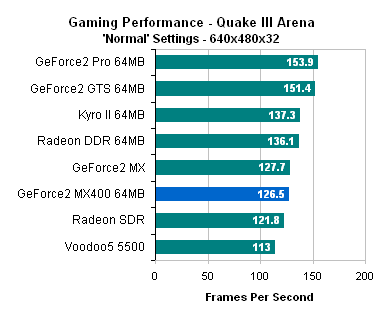
Of all the performance gains that an extra 25MHz core clock would give, we expected to see the most performance increase at low resolutions, including at 640x480x32 as shown above. Unfortunately, it seems that even at this resolution, the memory bus is overstrained, meaning that the extra core speed of the GeForce2 MX 400 is unable to be harnessed in any way. This is clearly shown above with both the original 175MHz GeForce2 MX performing essentially identically to the 200MHz GeForce2 MX 400.
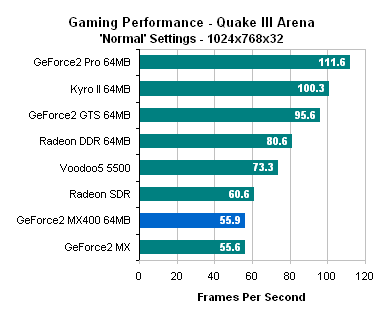
The same lack of improvement is present at 1024x768x32. With the GeForce2 MX 400 scoring only .3 FPS faster than the GeForce2 MX, the difference between the two cards at this resolution is nonexistent. Judging by the look of things so far, NVIDIA may as well just left the GeForce2 MX alone and not even bothered to up the core clock speed at all.
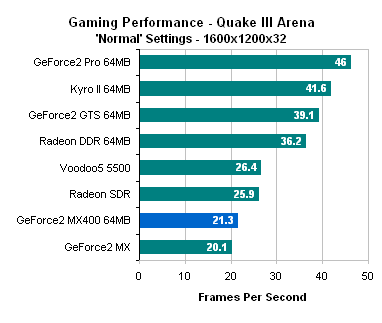
Finally, at 1600x1200x32, the GeForce2 MX 400 is able to slightly distinguish itself from the original GeForce2 MX. However, judging by the large amount of data that must pass over the memory bus at this resolution as well as the complexity of scenes here, it is more likely that the additional 32MB of memory did more for the GeForce2 MX 400 than did the 25MHz increase in core clock speed. Outperforming the original MX by only 6%, the difference between the GeForce2 MX and the GeForce2 MX 400 could easily be caused by slight variations in card designs.
MDK2 Performance
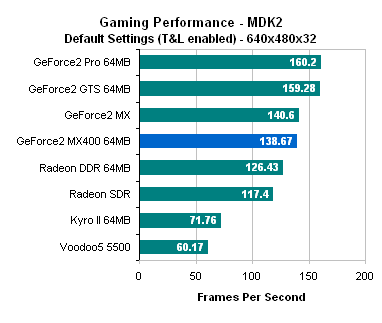
As we saw in Quake III Arena at 640x480x32, the GeForce2 MX 400 performs essentially identically to the GeForce2 MX. The increase in clock speed and the subsequent T&L performance increase cannot boost performance when having to deal with the extreme bottleneck at the memory bus level.
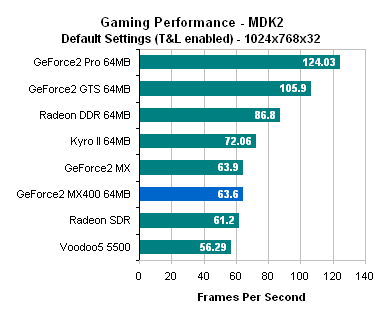
Again, at 1024x768x32, the GeForce2 MX 400 performs the same as the original GeForce2 MX, proving that core clock speed cannot make up for a slow memory pipeline.
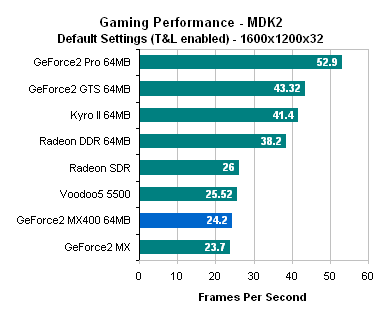
1600x1200x32 provides no new view of the GeForce2 MX 400. Performing an extremely marginal 2% faster than the lower clocked GeForce2 MX, the GeForce2 MX 400's speed increase can just as easily be attributed to the additional memory on the card as it can to the higher core clock speed.
UnrealTournament Performance
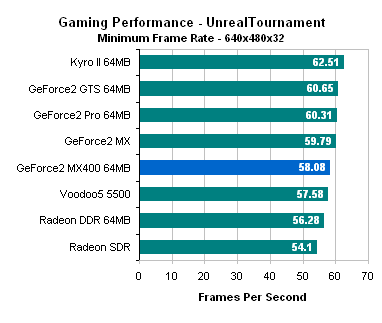
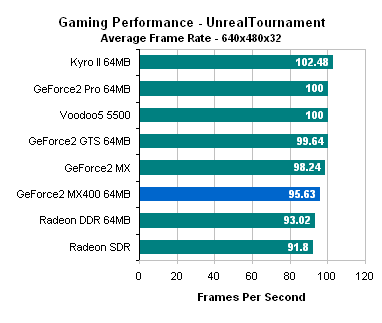
In Unreal Tournament at 640x480x32, not only are the differences in scores between the GeForce2 MX and the GeForce2 MX 400 insignificant, so are the differences in scores between almost every card.
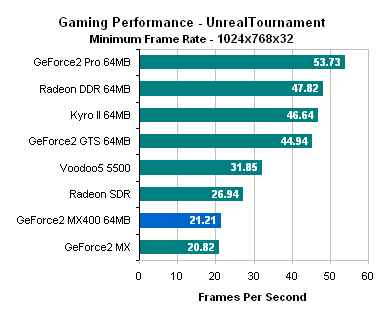
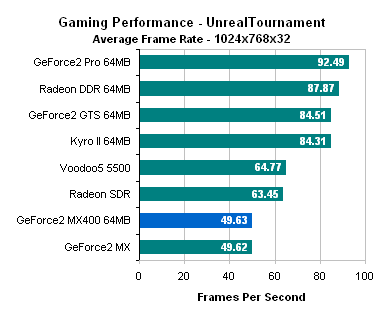
The differences in performance between the GeForce2 MX 400 and the GeForce2 MX in Unreal Tournament at 1024x768x32 really demonstrates the crippling aspect of the GeForce2 MX's memory bus. The performance difference between the two is, at the most, .4 FPS. One would have hoped that the 25MHz increase in clock speed would have done a bit more than that.
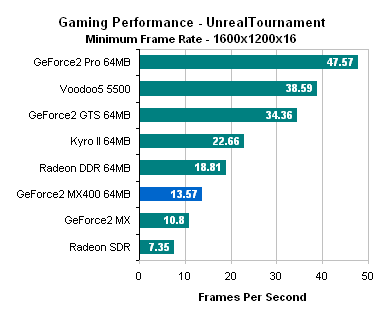
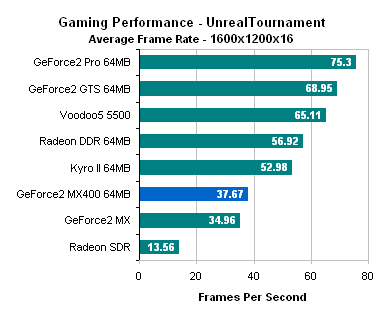
As the trend continues, we are finally able to see a very slight difference between the two cards at 1600x1200x16. Once again, with Unreal Tournament being a very texture intensive game, it is most likely that the additional 32MB of memory present on the GeForce2 MX 400 card we tested is responsible for the slight increase in performance.
Serious Sam Performance - Fill Rate
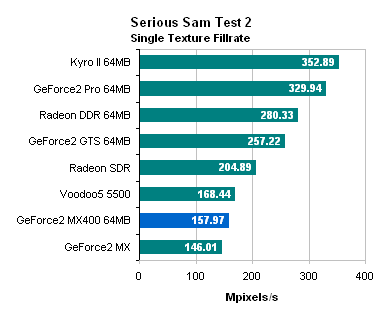
One of our favorite new tests, the Serious Sam benchmark, is able to demonstrate how much power the extra 25 MHz of speed is able to provide in a hypothetical situation. As you can see, the extra speed is able to increase the single texture fill rate of the GeForce2 MX 400 by 11.96 megapixels per second. As you can see, this falls way short of the theoretical 50 megapixels per second fill rate that the GeForce2 MX 400 should offer over the GeForce2 MX.
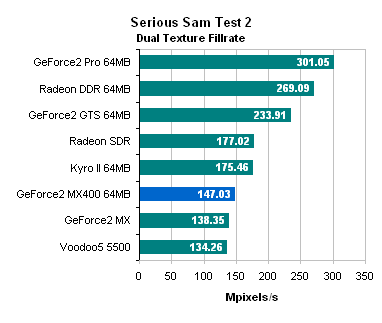
When multitexturing, the GeForce2 MX 400 gains 8.68 megapixels per second over the original GeForce2 MX. Once again, theoretically this number should be 25 megapixels per second, meaning that there is no question that the memory bus is holding the card back.
Serious Sam Performance - Game Play
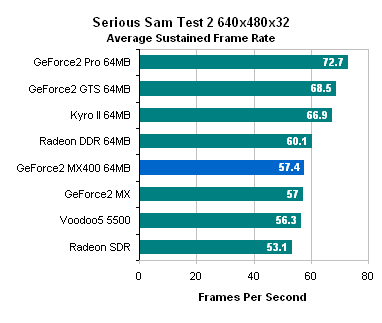
Similar to what we saw in other games at 640x480x32, the GeForce2 MX 400 is not able to really outperform the GeForce2 MX at 640x480x32. The two, as we have found so many time before, perform essentially identically.
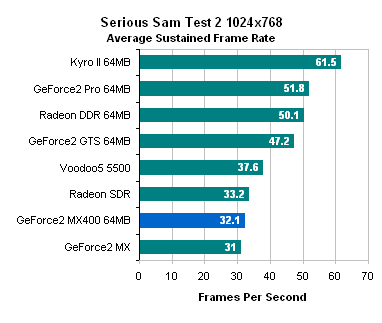
At 1024x768x32, the GeForce2 MX 400 shows a slight performance advantage over the GeForce2 MX. Performing 4% faster (1.1 FPS), the GeForce2 MX 400's increase in speed would not be noticed by even the most avid Serious Sam game player.
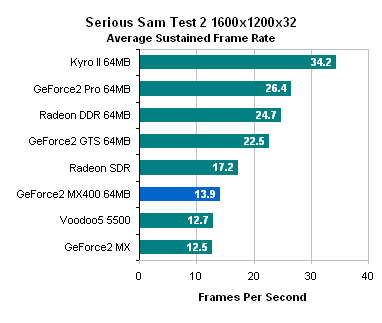
1600x1200x32, the GeForce2 MX 400 once again tries to prove its worth. Performing 11% faster than the GeForce2 MX, the difference is most likely due to the additional memory on the GeForce2 MX 400 we tested.
Even though there is a performance difference between the GeForce2 MX 400 and the GeForce2 MX, the frame rate at this resolution is too low to make it playable. This essentially renders the increase in speed useless, since no one will be playing at this resolution with these cards.
FSAA Performance
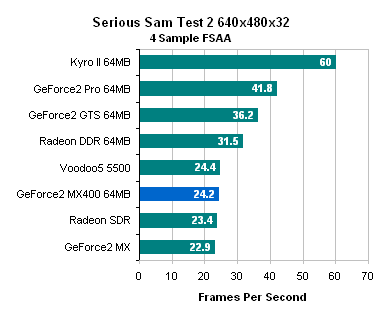
It is only really with FSAA enabled at 640x480x32 that we see any real performance gain from the GeForce2 MX 400's extra core speed. Performing 6% faster, the extra speed could prove to be useful in some cases. It is too bad, however, that the frame rate with FSAA enabled is so low that gameplay is jumpy here.
Once again, we can attribute some of the performance gain to the extra RAM on the GeForce2 MX 400 board we tested. FSAA enabled uses more memory than FSAA disabled (because a scene is rendered multiple times), so the extra memory most likely plays a role in the slight performance advantage of the GeForce2 MX 400.
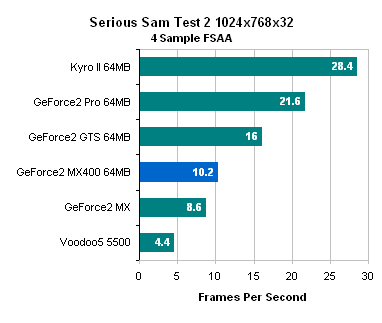
At 1024x768x32, even though the GeForce2 MX 400 is able to outperform the GeForce2 MX by 19%, the speed increase is useless. This is because running at 10.2 FPS as the GeForce2 MX 400 does at 1024x768x32 with FSAA 4X enabled is far too slow to be playing any game in, especially a first person shooter like Serious Sam.
Conclusion
Although it is clear that NVIDIA needed to address the workstation market competition coming from both ATI and Matrox, it is a bit vague why NVIDIA choose to update the standard GeForce2 MX. The GeForce2 MX 200 was necessary to bring NVIDIA's dual display solution down to the price that the Radeon VE and Matrox G450 cards are at, however NVIDIA's TwinView support remains the poorest performing of all three as far as dual display functionality goes. The reason for the GeForce2 MX 400's higher clock speed is rather puzzling. To top it all off, there is no question that the "new" GeForce2 MX line will cause some confusion, especially as retailers try to get rid of their original GeForce2 MX stash.
If we had heard 10 months ago that NVIDIA would be upping the core clock speed of the GeForce2 MX without changing the memory bus at all, we could have predicted that essentially no performance would be gained. We showed in our Overclocking the GeForce2 MX guide that even a 50 MHz increase in the GeForce2 MX clock speed resulted in only performance gains in the tenths of a frame. As it turns out, the GeForce2 MX 400 lives up to this prediction. The conclusion is simple: the GeForce2 MX is far too memory bandwidth limited to benefit from any increase in core clock.
Our suggestion for GeForce2 MX 400 cards? Get them only after all GeForce2 MX cards are gone. Prices of the original GeForce2 MX based cards should be dropping as venders try to make room for GeForce2 MX 400 and GeForce2 MX 200 based cards. If you can find a good deal on an original GeForce2 MX, by all means go for it. After some time, the GeForce2 MX 400 should replace the GeForce2 MX for good. At that time, just think of the GeForce2 MX 400 as the original GeForce2 MX because judging by its performance, the two are the same.
We would like to thank http://www.newegg.com for providing us with the Leadtek GeForce2 SH Max board, which is available now for $125.00.

